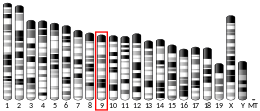DPY19L2
Dpy-19-like 2 (C. elegans) is a protein that in humans is encoded by the DPY19L2 gene.[5]
| DPY19L2 | |||||||||||||||||||||||||
|---|---|---|---|---|---|---|---|---|---|---|---|---|---|---|---|---|---|---|---|---|---|---|---|---|---|
| Identifiers | |||||||||||||||||||||||||
| Aliases | DPY19L2, SPATA34, SPGF9, dpy-19 like 2 | ||||||||||||||||||||||||
| External IDs | OMIM: 613893 MGI: 2444662 HomoloGene: 77569 GeneCards: DPY19L2 | ||||||||||||||||||||||||
| |||||||||||||||||||||||||
| |||||||||||||||||||||||||
| |||||||||||||||||||||||||
| Orthologs | |||||||||||||||||||||||||
| Species | Human | Mouse | |||||||||||||||||||||||
| Entrez | |||||||||||||||||||||||||
| Ensembl | |||||||||||||||||||||||||
| UniProt | |||||||||||||||||||||||||
| RefSeq (mRNA) | |||||||||||||||||||||||||
| RefSeq (protein) | |||||||||||||||||||||||||
| Location (UCSC) | Chr 12: 63.56 – 63.67 Mb | Chr 9: 24.56 – 24.7 Mb | |||||||||||||||||||||||
| PubMed search | [3] | [4] | |||||||||||||||||||||||
| Wikidata | |||||||||||||||||||||||||
| |||||||||||||||||||||||||
Function
The protein encoded by this gene belongs to the dpy-19 (developmental pluripotancy-associated) family. It is highly expressed in testis, and is required for sperm head elongation and acrosome formation during spermatogenesis. Mutations in this gene are associated with an infertility disorder, spermatogenic failure type 9 (SPGF9).
gollark: Maybe I should have tried having Codex do it.
gollark: Thanks to the unlimited power of procrastinating on doing other things, I also made my GPU-accelerated ~~fan noise generator~~ mandelbrot renderer actually work.
gollark: Ah.
gollark: I did find some random online tools but they appeared to not actually work.
gollark: Interesting, how were you able to decode it?
References
- GRCh38: Ensembl release 89: ENSG00000177990 - Ensembl, May 2017
- GRCm38: Ensembl release 89: ENSMUSG00000085576 - Ensembl, May 2017
- "Human PubMed Reference:". National Center for Biotechnology Information, U.S. National Library of Medicine.
- "Mouse PubMed Reference:". National Center for Biotechnology Information, U.S. National Library of Medicine.
- "Entrez Gene: Dpy-19-like 2 (C. elegans)".
Further reading
- Harbuz R, Zouari R, Pierre V, Ben Khelifa M, Kharouf M, Coutton C, Merdassi G, Abada F, Escoffier J, Nikas Y, Vialard F, Koscinski I, Triki C, Sermondade N, Schweitzer T, Zhioua A, Zhioua F, Latrous H, Halouani L, Ouafi M, Makni M, Jouk PS, Sèle B, Hennebicq S, Satre V, Viville S, Arnoult C, Lunardi J, Ray PF (March 2011). "A recurrent deletion of DPY19L2 causes infertility in man by blocking sperm head elongation and acrosome formation". American Journal of Human Genetics. 88 (3): 351–61. doi:10.1016/j.ajhg.2011.02.007. PMC 3059422. PMID 21397064.
- Coutton C, Zouari R, Abada F, Ben Khelifa M, Merdassi G, Triki C, Escalier D, Hesters L, Mitchell V, Levy R, Sermondade N, Boitrelle F, Vialard F, Satre V, Hennebicq S, Jouk PS, Arnoult C, Lunardi J, Ray PF (August 2012). "MLPA and sequence analysis of DPY19L2 reveals point mutations causing globozoospermia". Human Reproduction. 27 (8): 2549–58. doi:10.1093/humrep/des160. PMID 22627659.
- Elinati E, Kuentz P, Redin C, Jaber S, Vanden Meerschaut F, Makarian J, Koscinski I, Nasr-Esfahani MH, Demirol A, Gurgan T, Louanjli N, Iqbal N, Bisharah M, Pigeon FC, Gourabi H, De Briel D, Brugnon F, Gitlin SA, Grillo JM, Ghaedi K, Deemeh MR, Tanhaei S, Modarres P, Heindryckx B, Benkhalifa M, Nikiforaki D, Oehninger SC, De Sutter P, Muller J, Viville S (August 2012). "Globozoospermia is mainly due to DPY19L2 deletion via non-allelic homologous recombination involving two recombination hotspots". Human Molecular Genetics. 21 (16): 3695–702. doi:10.1093/hmg/dds200. PMID 22653751.
- Carson AR, Cheung J, Scherer SW (March 2006). "Duplication and relocation of the functional DPY19L2 gene within low copy repeats". BMC Genomics. 7: 45. doi:10.1186/1471-2164-7-45. PMC 1475853. PMID 16526957.
- Coutton C, Abada F, Karaouzene T, Sanlaville D, Satre V, Lunardi J, Jouk PS, Arnoult C, Thierry-Mieg N, Ray PF (March 2013). "Fine characterisation of a recombination hotspot at the DPY19L2 locus and resolution of the paradoxical excess of duplications over deletions in the general population". PLOS Genetics. 9 (3): e1003363. doi:10.1371/journal.pgen.1003363. PMC 3605140. PMID 23555282.
This article incorporates text from the United States National Library of Medicine, which is in the public domain.
This article is issued from Wikipedia. The text is licensed under Creative Commons - Attribution - Sharealike. Additional terms may apply for the media files.



